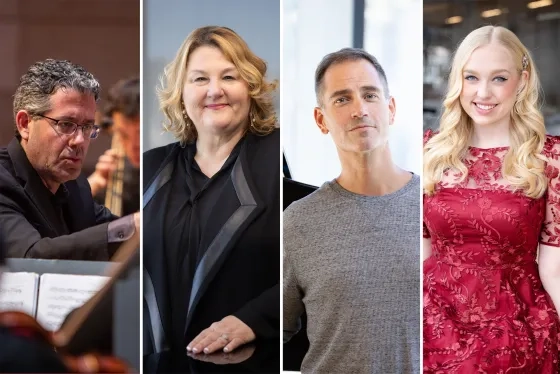A Rare Glimpse at What Early Broadway Sounded Like, Thanks to Historical Performance and Voice
News StoryThe performance is part of the larger efforts of the Studio for the Early American Musical, dedicated to exploring music from early Broadway, vaudeville, and film.
When most people picture "Broadway music," it's often the great cinematic adaptations by MGM or big-budget modern-day productions on the Great White Way that come to mind. But SFCM's Historical Performance (HP) Department, in conjunction with Voice and Opera Studies Department faculty and the Studio for the Early American Musical, is shining a light on a less-remembered era.
"The flourishing of American popular music in the early 20th century coincided with the rise of the recording industry," says Eric Davis, co-director of the Studio. "But most of the orchestral scores written during this era were thrown out, so what remains is the piano and voice sheet music and the historical recordings.”
The program for the September 29 performance features not only lesser-known songs from legends like Gershwin and Cole Porter but lesser-known composers like Kay Swift and Frank Tours. One historical note that's important, Jamason says, is that amplification didn't come to Broadway until the 1960s, so hearing the songs presented acoustically is the most accurate setting for them. Selections range from 1915 to World War II, covering ragtime, foxtrot, and the swing era. "They're all distinct, and while this is all meant to be fun, not at all a history lesson, there is a lovely chronology to the evening," HP Chair Corey Jamason (also co-director of the Studio for the Early American Musical), says.
"We love how these songs became a part of the Great American Songbook," he adds. "We are fascinated by how they've been explored and developed by cabaret artists, by jazz artists, by current Broadway artists. But something really interesting happens when listening to historical recordings from the Teens and Twenties of the 20th century and saying, 'Well, how did the original creators do it? We are constantly inspired by the style of these performers. Their incredible energy, passion, and joy is what we are trying to emulate."
Many composers of the era often wrote songs with a specific singer/performer in mind, so, Jamason continues, "That's what we did with our Voice alumni as well as Voice faculty like Matthew Worth and (Voice/Opera Studies Chair Catherine Cook, matching their incredible gifts and artistry to specific songs.”
The afternoon leads into the following week's Historical Performance concert on October 6, which features many female lyricists and composers. “Creators like Kay Swift, who was a friend of [George] Gershwin, deserve to be much better known. Even though early Broadway was very male-dominated, we have amazing songs from Swift, and from Dana Suesse and Ann Ronell and incredible lyrics by Dorothy Fields, so there is a lot of unknown music to explore and to celebrate.”
SFCM Voice department alumni participating include sopranos Taylor See and Camryn Finn, mezzos Leah Finn and Katherine Growdon, and tenor Brian Thorsett, with Matthew Worth providing the baritone.
"We want to give singers the opportunity to sing these songs in this format and style, and they'll be bringing their own voice to the performance, but it's also a good opportunity to do a bit of play-acting that they maybe don't get to as much normally," Davis says. "I'm excited to see what they do with it."
Learn more about studying Voice or Historical Performance at SFCM.

